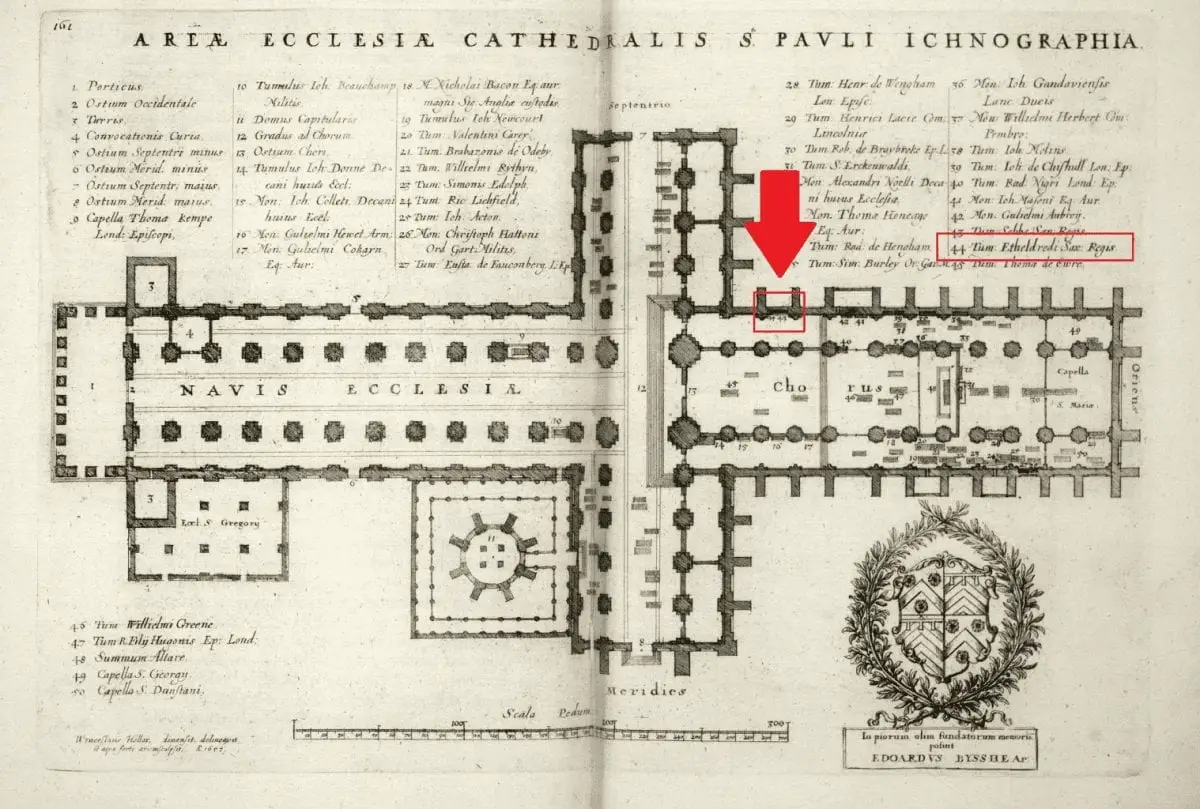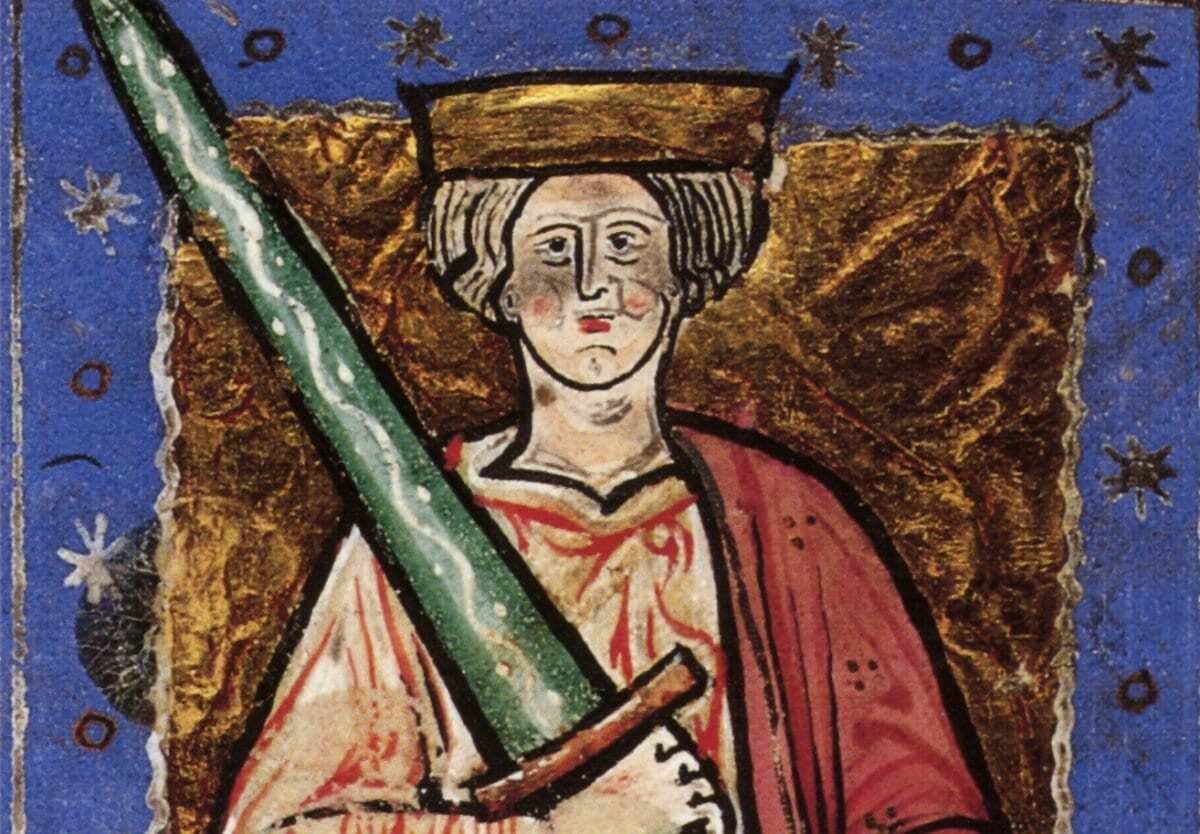Æthelred II, also dubbed the Unready was King of Saxon England during 978–1013 and 1014–1016.
Under his father Kind Edgar, England had experienced a period of peace after the reconquest of the Danelaw in the mid-10th century. However, beginning in 980, small bands of Danish invaders carried out coastline raids testing defences across England that included Hampshire, Thanet, Cornwall, Dorset and Cheshire.
After several successful Danish raids such as the Battle of Maldon, where a sizable Danish fleet defeated Byrhtnoth, ealdorman of Essex, Æthelred turned to paying tributes to hold off the invaders and keep the peace in his realm.
This policy was to change when Æthelred ordered the massacre of all Danish men in England to take place on 13 November 1002, St Brice’s Day, otherwise called the “St. Brice’s Day Massacre.” It is thought that Gunhilde, sister of Sweyn Forkbeard, King of Denmark, was said to have been among the victims.
Historians have generally viewed the massacre as a political act which helped to provoke Sweyn’s invasion of 1003. In 1004, after the Danish sacking of Norwich, the Anglo-Saxon Chronicle reports a bloody battle between the East Anglians led by Ulfcytel Snillingr and an army led by Swein Forkbeard.
The Chronicle states that Ulfcytel and the “councillors in East Anglia” attempted to buy a truce with Swein, but that the Danes broke the truce and marched to Thetford where a part of the East Anglian fyrd engaged them.
The battle seems to have been a draw as the Danes managed to escape. Two of the Chronicle manuscripts state that the Danes later “admitted that they had never met with harder hand-play [fighting] in England than Ulfcytel gave them”. The Danish army left England for Denmark in 1005, perhaps because of their injuries sustained in East Anglia, or perhaps from the very severe famine which afflicted the continent and the British Isles in that year.
Sweyn later returned to England in 1013 with an invading force intent on crowning him King of England. By the end of 1013, English resistance had collapsed and Sweyn had conquered the country, King Æthelred sent his sons Edward (Ironside) and Alfred to Normandy, and retreated to the Isle of Wight, where he fled overseas in exile to seek support from his ally, the Norwegian king Olaf.
In 1014, Sweyn suddenly died, leaving his son Cnut the Great as King, but secretly a deputation was sent to Æthelred to restore him to the throne. Æthelred then launched an expedition against Cnut and his allies, the men of the Kingdom of Lindsey. Cnut’s army had not completed its preparations and, in April 1014, he decided to withdraw from England without a fight leaving his Lindsey allies to suffer Æthelred’s revenge.
A Norse saga tells of a battle when King Æthelred returned to attack Danish-occupied London.
According to the saga, the Danes lined London Bridge and showered the attackers with spears. Undaunted, the attackers pulled the roofs off nearby houses and held them over their heads in the boats. Thus protected, they were able to get close enough to the bridge to attach ropes to the piers and pull the bridge down, thus ending the Viking occupation of London.
Viking Invasion by Cnut the Great
War loomed again, when in the summer of 1015, Cnut the Great, son of Sweyn Forkbeard set sail for England with a Danish army of perhaps 10,000 men in 200 longships. The invasion force was to engage in close and grisly warfare with the English for the next fourteen months.
Cnut eventually conquered most of England, while Edmund rejoined Æthelred to defend London where Æthelred subsequently died on 23 April 1016. The subsequent war between Edmund and Cnut ended in a decisive victory for Cnut at the Battle of Ashingdon on 18 October 1016.

Cnut maintained his power over England by uniting Danes and Englishmen under cultural bonds of wealth and custom, rather than by sheer brutality. The protection he lent against Viking raiders (many of them formerly under his command) restored the prosperity that had been increasingly impaired in England.
Historian Norman Cantor went further to make the statement that he was “the most effective king in Anglo-Saxon history”, despite him not being Anglo-Saxon.
In contrast, Æthelred went down in history as being branded with the notorious nickname “unready”, from Old English Æþelræd Unræd. Bosworth-Toller’s Anglo-Saxon Dictionary defines the noun unræd in various ways, but generally it means “evil counsel”, “bad plan”or “folly”.
The epithet would seem to describe the poor quality of advice which Æthelred received throughout his reign, presumably from those around him, specifically from the royal council, known as the Witan. Though the nickname does not suggest anything particularly respectable about the king himself, its invective is not actually focused on the king but on those around him, who were expected to provide the young king with god ræd (i.e. good counsel).
Æthelred was buried in Old St Paul’s Cathedral, London, where he was placed next to King Sæbbi of Essex (d.697). The location of his tomb was outlined in the plan of the Cathedral created by Wenceslaus Hollar in 1658, where much of the detailed information historians have of the cathedral is taken from William Dugdale’s 1658 History of St Pauls Cathedral.


The tomb and his monument were later destroyed along with the cathedral in the Great Fire of London in 1666.
King Æthelred the Unready remains the last monarch to be buried at St Paul’s..A modern monument in the crypt lists his among the important graves lost to time….
Header Image Credit: Æthelred the Unready- Scanned from the book The National Portrait Gallery History of the Kings and Queens of England by David Williamson







